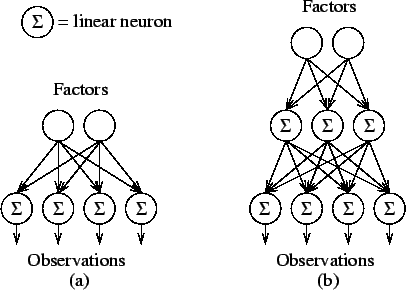



Next: Algorithms
Up: Linear Gaussian factor analysis
Previous: Linear Gaussian factor analysis
It is somewhat artificial to call the linear factor analysis model a
neural network, but it serves as a good starting point for the later
development. The structure of neural networks is usually represented
graphically by showing the computational elements, neurons, of the
network. Each node corresponds to one neuron and the arrows usually
denote weighted sums of the values from other neurons. It should be
noted that although this representation bears resemblance to graphical
models, a graphical model represents the conditional dependences
while the neural network representation shows the computational
structure. In general, these representations are therefore different.
The linear factor analysis model can be represented as a neural
network with two layers![[*]](foot_motif.gif) . On the first layer there are the
factors and the second layer consists of linear neurons which compute
a weighted sum of their inputs. A network interpretation of a model
with two-dimensional factors and four-dimensional observations is
depicted schematically in figure 5a. The weights
Aij are shown as links between the nodes but the biases ai are
not shown.
. On the first layer there are the
factors and the second layer consists of linear neurons which compute
a weighted sum of their inputs. A network interpretation of a model
with two-dimensional factors and four-dimensional observations is
depicted schematically in figure 5a. The weights
Aij are shown as links between the nodes but the biases ai are
not shown.
Figure 5:
(a) The linear factor analysis model can be interpreted as a
neural network with one layer of linear neurons. The arrows
represent connections with weights Aij attached to them. (b)
A multi-layer structure can be replaced by a single layer of
linear neurons.
 |
Linear neurons as building blocks for larger networks are too
simplistic because adding extra layers of linear neurons does not
increase the representational power of the network. This is easily
seen by considering the model
|
x(t) = B (A s(t) + a) + b
+ n(t),
|
(29) |
shown in figure 5b. By setting
A' =
BA and
a' = Ba + b the
model can be written as
|
x(t) = A' s(t) + a' + n(t),
|
(30) |
which, interpreted as a neural network, has only one layer of linear
neurons.




Next: Algorithms
Up: Linear Gaussian factor analysis
Previous: Linear Gaussian factor analysis
Harri Valpola
2000-10-31
![[*]](foot_motif.gif) . On the first layer there are the
factors and the second layer consists of linear neurons which compute
a weighted sum of their inputs. A network interpretation of a model
with two-dimensional factors and four-dimensional observations is
depicted schematically in figure 5a. The weights
Aij are shown as links between the nodes but the biases ai are
not shown.
. On the first layer there are the
factors and the second layer consists of linear neurons which compute
a weighted sum of their inputs. A network interpretation of a model
with two-dimensional factors and four-dimensional observations is
depicted schematically in figure 5a. The weights
Aij are shown as links between the nodes but the biases ai are
not shown.
